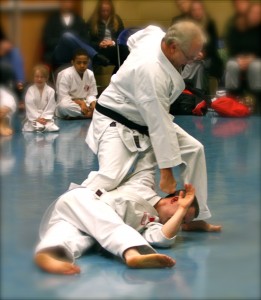By Mick Simmonds
For those of us fortunate enough to have found ‘Karate’ will know that there are stages you pass through in your karate journey, which can also be attributed to age ranges.
When you first start the journey, white to blue belt (youth) you will be full of excitement with the challenges that are presented to you with each lesson you partake in, allowing ego to flourish as we develop and move into explosive movement with powerful, aggressive but controlled techniques.
You will also realise that training once a week, just isn’ t enough for you and to satisfy your enthusiasm for the training and developing friendships, you’ll make a life-long decision to train at least twice a week if not three times, this will translate into accelerated learning of kumite technique and higher levels of kata as you accelerate your climb along the grading ladder compared to someone training just once a week.
Guess what? Your confidence will also develop and grow, to where–when called upon you can stand out front and take a class through a warm-up routine and beyond, which can only help everyone in so many different facets of everyday living
Some way into the journey, possibly purple or brown belt level (middle years) you may now start to show some signs of your time training, such as the odd niggle here & there as you stretch or try to achieve that jodan mae geri, which is where we start to think about the mechanics of the physical movement to understand how our body & limbs can do what it can, and what we need to do to protect those limbs, joints from being damaged.
This is a must-do thing for those who wish to have a long and relatively injury free journey – to ignore this can only lead to injury which can possibly affect day-to-day life.,
So when you are in class and attempting that elusive mawashi geri and the Sensei shouts out, bend the supporting leg, turn more on the ball of the foot – it’s not only technique they are helping you to achieve, but also helping you to protect the knee joints, hips etc from any strain injuries.
At this time you may notice a slight slowing of that explosiveness that you first had at the start of your journey, and this is where the development of tanden/hara/ kime/core/centre/breath/ posture will start to become an ever more important and a developing area of your training.
With better understanding and training in this important area instead of big, expansive or explosive movements you will start to internalise your movements instead and still achieve if not improve the end result, the additional benefit will come from reducing the wear & tear on joints and limbs, and those of us who have a back-problem will benefit immensely and help carry you further along the karate path.
This being said, to achieve this result will take a karate lifetime and something, some us will not fully achieve the perfection of Tanden – Core – Internalised movement, etc, but your greater understanding will assist you in continued training into Black Belt or maturity , (yes ok, old age). The depth of stances may not be as deep as a teenager or as externally explosive, but will be just as strong if not stronger due to a developed Tanden-Core and internalised movements. You may also find that where a youngster will do 100 hard/fast chudan tsuki strikes you will only do 50 hard/fast strikes but the first 50 will be of a slower, higher level of technique.
There will be days where the pressures of everyday life will be so much that the thought of getting the gi on and going to the dojo that evening is the last place you want to be, much preferring to be in the armchair in front of the T V . But guess what… you make that effort to go to the dojo and train with fellow karateka and just for a while the pressures melt away and leave you in a better frame of mind to face them later-on. So don’t fall into the trap of skipping classes as the benefit to ‘self’ is immeasurable in so many different ways, this was once again brought home to me at a recent class, when a student admitted after the class had ended that they had thought of skipping class, but felt so much better for having attended and couldn’ t wait for the next class to roll round and train again.
By now your high grade level will mean that you will have younger students or lower grades full of enthusiasm to learn, looking to you for that help with extra instruction/assistance. This in turn will enthuse you to learn more by practice and by reading martial arts material to expand your knowledge, to delve into bunkai (practical applications) – to look at why something works in this situation and not in others and what else can be done with a particular technique – I’m sure that once you immerse yourself into this subject alone, the quest for knowledge grows without limit and the rewards you get from passing your knowledge on is again without measure.
As a slight aside, if you have an injury – do not ignore it, seek assistance be it medical or other means, those who know me, they will be aware that I have a few injuries here & there and that to control/manage these and avoid further injury I have preventative treatments on a regular basis from a sports masseur, which not only allows me to continue with regular training, but also day-to-day family/work life. Should anyone wish to be referred to a sports masseur a few of us in Seitou Ryu see a couple of very capable sports therapists (one male, one female) for treatments, anyone wanting their contact details should ask their class Sensei.
